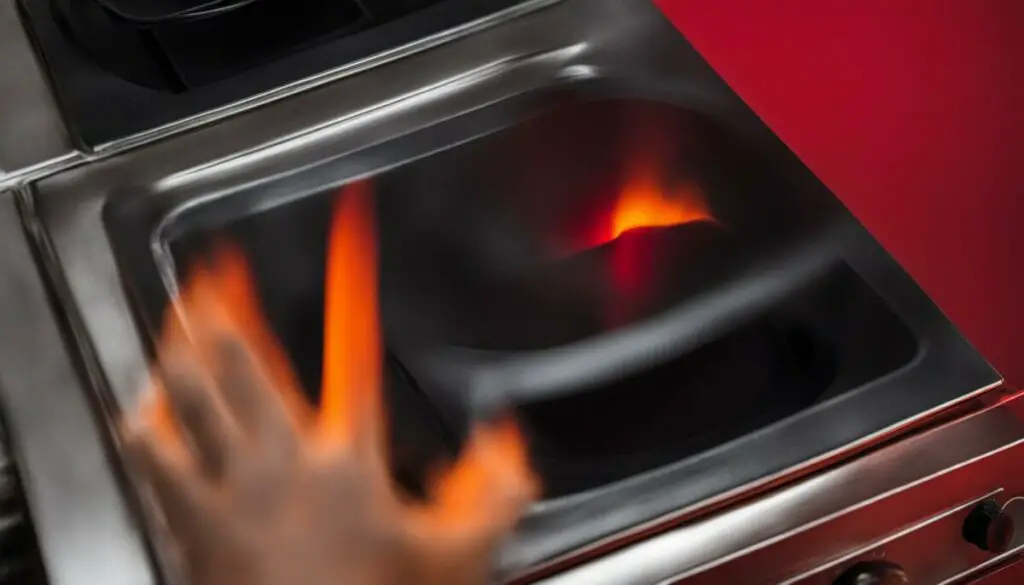Last Updated on 6 months by Francis
Have you ever wanted to detect invisible light without the need for specialized equipment? Infrared rays are a type of electromagnetic radiation that is all around us, but how can a person detect them without an instrument? In this section, we will explore various techniques and methods that individuals can use to detect infrared rays without the need for specialized instruments or equipment.
Discover how you can use your skin’s sensitivity, observe temperature differences, utilize common materials found around the house, and even create DIY infrared detectors. We will also delve into the concepts of reflection and emission, and how they can assist in detecting infrared rays.
Contents
Key Takeaways:
- There are various techniques and methods that individuals can use to detect infrared rays without the need for specialized instruments or equipment.
- These methods include utilizing your skin’s sensitivity, observing temperature differences, utilizing common materials found around the house, creating DIY infrared detectors, and understanding the concepts of reflection and emission.
- By utilizing these techniques, individuals can uncover the hidden world of infrared radiation and expand their understanding of invisible light detection.
Understanding Infrared Radiation

Before we dive into the techniques for detecting infrared rays without instruments, let’s first understand what infrared radiation is. Infrared radiation, also known as IR radiation, is a type of electromagnetic radiation that is invisible to the naked eye. It is found next to visible light on the electromagnetic spectrum, with longer wavelengths and lower frequencies.
Infrared radiation is emitted by all objects that have a temperature above absolute zero, including human bodies, animals, and inanimate objects such as buildings or vehicles. This makes it a useful tool for a variety of applications, including thermal imaging and remote sensing.
When it comes to infrared rays detection techniques, it is important to note that detecting infrared radiation without tools can be challenging. IR radiation cannot be seen, heard, or felt, making it difficult to detect without specialized instruments. However, there are several methods that individuals can use to detect the presence of infrared rays without the need for instruments.
Some methods for detecting infrared radiation without tools include:
- Using your skin’s sensitivity
- Observing temperature differences
- Using common materials
- Utilizing color filters
- Exploring biological indicators
- Understanding reflection and emission
- Harnessing the power of heat
“Infrared radiation, also known as IR radiation, is a type of electromagnetic radiation that is invisible to the naked eye.”
Each of these methods has its own advantages and disadvantages, and some may be more effective than others depending on the specific situation. In the following sections, we will explore each of these methods in more detail, providing insights into how they work and when to use them.
Using Your Skin’s Sensitivity

Did you know that your skin can detect infrared radiation? This is because infrared rays produce heat, which is what your skin is designed to sense.
If you place your hand near a source of infrared radiation and move it closer and further away, you may be able to feel a slight difference in temperature. This method of manual detection can be a useful tool for detecting IR rays without equipment.
Another technique involves using your face instead of your hand. Close your eyes and turn your head so that your face is parallel to the surface you want to scan. Move your head slowly left and right while keeping your eyes closed. When your face is parallel to a source of infrared radiation, you may feel a slight warmth on one side of your face.
While using your skin’s sensitivity may not be the most precise method of detecting infrared radiation, it can be a useful tool when other methods are not available.
It is important to note that if you are attempting to detect IR rays using your skin, you should not expose yourself to potentially harmful sources of radiation. Always prioritize your safety and protection.
Observing Temperature Differences
One of the most accessible methods for detecting infrared radiation without instruments involves observing temperature differences. Infrared radiation is a type of electromagnetic radiation that is emitted by objects with heat. The hotter an object is, the more infrared radiation it emits.
To identify IR rays without instruments, look for temperature differences in the environment. A simple way to identify temperature differences is by using your hands. Place your palms a few inches away from different surfaces and objects, and see if you can feel a difference in temperature. Be sure to warm your hands first by rubbing them together, to get a better sense of what you should be feeling.
If you want to get more precise, you can use a temperature sensor, such as an infrared thermometer. These devices can measure the temperature of an object by detecting the infrared radiation it emits. However, this is not considered a “DIY infrared detection technique,” as it requires specialized equipment.
Creating a DIY Temperature Sensor
If you’re up for a more advanced DIY project, you can create your own temperature sensor using everyday household items. One popular method involves using a thermistor, which is a type of resistor that changes its resistance value with changes in temperature. By measuring the resistance of the thermistor, you can determine the temperature of the object it is in contact with.
To create a DIY temperature sensor, you will need the following items:
| Item | Quantity |
|---|---|
| Thermistor | 1 |
| Resistor (10kΩ) | 1 |
| Battery (9V) | 1 |
| Breadboard | 1 |
| Jumper Wires | Assorted |
For detailed instructions on how to assemble the DIY temperature sensor, check out this Arduino Temperature Sensor Thermistor Tutorial.
By observing temperature differences or creating your own DIY temperature sensor, you can detect infrared radiation without the need for specialized instruments or equipment. These DIY infrared detection techniques are perfect for anyone interested in exploring the world of invisible light detection!
Using Common Materials to Detect Infrared Waves

If you don’t have access to specialized equipment, don’t worry, you can still detect infrared radiation using common materials found around the house. Here are a few methods to try:
- Black paper or cloth: Place a piece of black paper or cloth over an object that emits heat, such as a light bulb. The paper or cloth will absorb the visible light and allow the infrared radiation to pass through, making it visible to the naked eye.
- Remote control: Point a remote control at your smartphone camera and press any button. The camera should detect the infrared signal and display it as a flashing light on the phone screen.
- Water: Fill a clear glass with hot water and hold it up to your eye. Any objects emitting infrared radiation nearby will appear distorted in the water due to the varying refractive index.
Using these simple materials, you can easily detect infrared waves without any specialized equipment. Give them a try!
Utilizing Color Filters

If you want to enhance your ability to detect natural infrared radiation, color filters can help. By blocking out visible light, color filters reveal hidden infrared radiation. The filters work by only allowing specific colors of light to pass through, enhancing the contrast between visible light and infrared radiation.
Color filters are readily available and can be purchased online or from photography stores. To use a color filter, place it in front of your eyes or your camera lens when observing your surroundings.
Note: When using a color filter, do not look directly at the sun or other bright light sources, as this can cause permanent damage to your eyesight.
Some common color filters used for detecting infrared radiation include:
| Filter Color | Wavelength | Use |
|---|---|---|
| Red | 600-700 nm | Reveals hotspots and temperature changes, perfect for outdoor detection |
| Yellow | 500-600 nm | Reveals heat images from below the surface in soil and water |
| Orange | 580-600 nm | Filters out reflected light, useful for detecting natural infrared radiation indoors |
Experiment with different color filters to see which ones work best for your needs, and don’t be afraid to get creative! By using color filters, you can unlock a new dimension of invisible light detection.
Creating DIY Infrared Detectors

If you’re a hands-on type of person, building your own DIY infrared detectors can be a fun and rewarding project. There are various methods of creating your own infrared detector, but we’ll cover two of the most accessible ways.
Method 1: Using a Photodiode
A photodiode is a simple electronic device that converts light into electrical current. By wiring a photodiode to a sound generator, you can create a device that emits an audible tone when exposed to infrared radiation. Here’s a step-by-step guide:
- Obtain a photodiode and a 2N3904 transistor. You can find these at any electronics store or online.
- Connect the photodiode to the transistor by wiring the cathode of the photodiode to the base of the transistor and the anode to the collector of the transistor.
- Connect a resistor to the base of the transistor and wire this to a speaker or headphones.
- When the photodiode is exposed to infrared radiation, it will generate current, causing the transistor to switch on and emit a sound through the speaker.
Method 2: Using a Digital Camera
Another way to create your own DIY infrared detector is by using a digital camera. Most digital cameras have a sensor that is sensitive to infrared radiation, but they are equipped with a filter that blocks out this type of light. By removing the filter, you can use the camera to detect infrared radiation. Here’s how:
- Obtain a digital camera with a removable lens and an infrared filter. You can find tutorials online that show you how to remove the filter.
- Once the filter is removed, your camera will be sensitive to infrared radiation. To test it, point a TV remote at the camera and press a button. If you see a light on the camera screen, it means the camera is detecting the infrared radiation from the remote control.
- You can now use your camera to detect infrared radiation in your surroundings. Take photos with the camera and check for areas that appear bright or glowing, indicating the presence of infrared radiation.
Remember to exercise caution when building your own DIY infrared detectors. Follow all safety precautions and consult a professional if you have any doubts.
Exploring Biological Indicators

If you’re looking for a more natural approach to detecting infrared radiation, consider turning to biological indicators. Some living organisms have evolved to detect infrared rays, and you can take advantage of their abilities to assist your own detection efforts.
Mosquitoes are one example of a biological indicator. They use infrared radiation to locate warm-blooded prey, which emits infrared radiation. By monitoring mosquito activity, you can determine if there are heat sources in your surroundings that are emitting infrared radiation.
Snakes are another type of animal that are known for their infrared detection abilities. They have specialized organs called pit organs that allow them to detect even the slightest temperature changes, as small as 0.003 degrees Celsius. While it may not be practical to adopt a snake as your personal infrared detector, observing their behavior can provide insight into the presence of infrared radiation in your environment.
Aside from living organisms, there are also biological materials that can be used as indicators of infrared radiation. For example, certain types of pollen can change color when exposed to infrared radiation, making them a useful tool for detection.
While using biological indicators may not be as precise as relying on specialized equipment, they can provide useful insights into the presence of infrared radiation in your surroundings. Additionally, utilizing biological indicators can be a fun and educational way to learn more about the natural world and the ways in which living organisms adapt to their environments.
Understanding Reflection and Emission

Reflection and emission of infrared radiation can provide valuable clues to its presence. To understand how reflection and emission work, we need to first discuss the nature of infrared radiation.
Infrared radiation is a type of electromagnetic radiation that has a longer wavelength than visible light. It is emitted by all objects that have a temperature above absolute zero. This means that infrared radiation is continually being emitted by objects in our surroundings, even if we cannot see it.
When infrared radiation encounters an object, there are two possible outcomes: reflection or emission. Reflection occurs when the infrared radiation bounces off the surface of an object, much like a ball bouncing off a wall. Emission occurs when the infrared radiation is absorbed by an object and then re-emitted in a different direction. Think of a glowing hot piece of metal being heated in a fire – it emits infrared radiation as it heats up.
So, how can we use reflection and emission to detect infrared rays without any equipment? One method is to look for objects that are reflecting or emitting more infrared radiation than their surroundings. For example, a hot cup of coffee will emit more infrared radiation than a cold glass of water.
Another method is to observe the reflection or emission of infrared radiation on different surfaces. For example, different materials will reflect or emit infrared radiation differently, such as metal surfaces reflecting more infrared radiation than wood surfaces. By observing these differences, we can begin to detect the presence of infrared radiation without the need for any specialized equipment.
In conclusion, reflection and emission of infrared radiation can be useful in detecting the presence of invisible light without specialized instruments. By observing the reflection or emission of infrared radiation on different surfaces and objects, we can begin to unlock the secrets of this fascinating type of electromagnetic radiation.
Harnessing the Power of Heat
One of the most natural ways to detect infrared radiation is by utilizing the power of heat sources. As we know, heat sources, whether it’s the sun or a fire pit, emit infrared radiation as a by-product of their energy output.
By observing the temperature changes around a heat source, you can detect the presence of natural infrared radiation. For instance, if you’re standing in a cold environment, such as a snowy forest, you can easily locate a source of natural infrared radiation, like a campfire. The heat emanating from the fire will cause the snow around it to melt faster than the surrounding snow, making it easily identifiable.
If you don’t have access to a heat source, consider using your own body as a heat source. For example, you can place one hand on a surface and observe the temperature changes with the other hand. If the surface emits infrared radiation, it will feel warmer than the surrounding areas.
It’s important to note that the effectiveness of this method depends on your ability to differentiate small temperature differences. With enough practice, however, detecting natural infrared radiation can become second nature.
Conclusion
As we have explored in this article, there are numerous techniques and methods for detecting infrared rays without the need for specialized instruments or equipment. From relying on your skin’s sensitivity to using common materials found around the house, there are plenty of DIY infrared detection techniques available to anyone willing to try.
Manual infrared detection methods also prove useful, as well as exploring the world of biological indicators and the fascinating concepts of reflection and emission. Utilizing heat sources and color filters can also enhance your ability to detect natural infrared radiation.
Through the use of these infrared rays detection techniques, you can unlock the secrets of invisible light detection and expand your understanding of the world around you. So why not embrace the challenge and start exploring the hidden world of infrared radiation today?
FAQ
How can a person detect infrared rays without an instrument?
There are several methods that individuals can use to detect infrared rays without specialized instruments. These include utilizing your skin’s sensitivity, observing temperature differences, using common materials, utilizing color filters, creating DIY infrared detectors, exploring biological indicators, understanding reflection and emission, and harnessing the power of heat.
What is infrared radiation?
Infrared radiation is a type of invisible light that exists on the electromagnetic spectrum. It has longer wavelengths than visible light and is commonly associated with heat.
Can your skin detect infrared rays?
Yes, your skin has the potential to detect infrared rays. By tapping into your skin’s sensitivity, you can identify the presence of infrared radiation without the need for instruments.
How can temperature differences help detect infrared rays?
Infrared radiation is often associated with temperature variation. By observing temperature differences in your surroundings, you can detect the presence of infrared rays without specialized equipment.
Can common materials be used to detect infrared waves?
Yes, you can use common materials found around the house to detect infrared radiation. These materials can help you identify the invisible infrared waves without the need for specialized tools.
How can color filters enhance infrared radiation detection?
Color filters can block out visible light and enhance your ability to detect natural infrared radiation. By utilizing color filters, you can reveal the presence of infrared radiation more effectively.
Are there DIY infrared detectors that can be built?
Yes, there are various DIY infrared detectors that you can build yourself. These detectors utilize everyday items and technology to help you detect infrared rays without relying on instruments.
Do living organisms have a natural ability to detect infrared radiation?
Yes, some living organisms possess the ability to detect infrared radiation. These biological indicators can aid in the detection of infrared rays without the need for instruments.
How do reflection and emission assist in detecting infrared rays?
Reflection and emission of infrared radiation can provide clues to its presence. By understanding these concepts, you can better detect infrared rays without specialized equipment.
Can heat sources be used to detect natural infrared radiation?
Yes, heat sources can emit infrared radiation, making them a valuable tool for detection. By harnessing the power of heat, you can detect natural infrared radiation in your surroundings.









